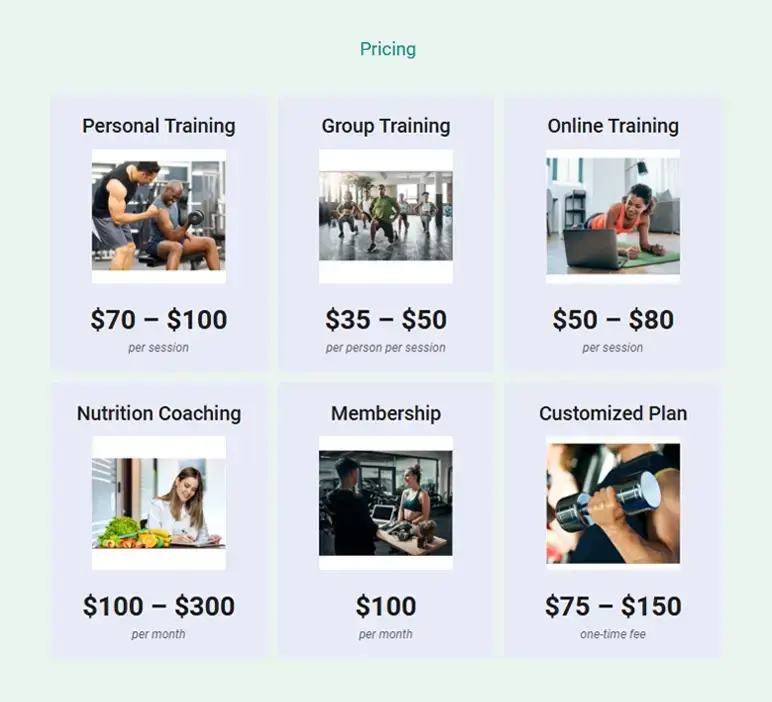Starting a personal training business isn’t just about workouts and meal plans. You’ve got to figure out your brand, get the right clients, and set a business that lasts.
It’s a lot. And honestly, most people don’t know where to begin.
To get some real answers, I spoke with Evan Mather, the founder of Custom Fit Personal Training & Nutrition. He shared how he got started, set his prices, and built a loyal client base.
From that conversation, I’ve prepared this guide to help you build a plan that actually works in the real world—not just on paper. Let’s begin with…
What is a personal trainer business plan?
A personal trainer business plan is a simple document that explains how you’re going to run your personal training business.
It typically covers what services you’ll offer, who your ideal clients are, how much you’ll charge, how you’ll find and keep clients, and how you’ll manage your money and day-to-day work.
Why is a business plan necessary for personal fitness training?
Whether you’re starting a new personal training business or already have experience, you need a solid personal trainer business plan to keep things clear.
Here’s why it matters:
- Sets clear goals for your business growth and long-term success.
- Attracts investors and lenders by showing a well-structured growth plan.
- Helps secure funding with a solid financial and marketing strategy.
- Prepares for challenges like competition, client retention, and market changes.
- Tracks progress so you can adjust, improve, and stay on the right path.
Without a plan, it’s easy to lose focus. So, keep a business plan that lets you stay focused, organized, and ready to grow your personal trainer venture!
How to create a solid personal training business plan?
When putting together a business plan for your personal training business, it’s essential to highlight key aspects that showcase your vision and strategy.
Here’s a straightforward guide to help you create a clear and impactful plan:

1. Executive Summary
The executive summary is the first section of your personal trainer business plan. It provides a quick snapshot of your business and highlights the key details.
The aim is to grab the reader’s attention – whether it’s an investor, partner, or lender – and make them want to know more. Keep it short, clear, and interesting.
Here's what to include in this section:
- Business model and objectives
- Growth opportunities in the fitness industry
- Ideal clients
- What makes your training services unique
- Marketing approach
- Financial projections overview
Think of it as a brief but powerful introduction that explains what your personal training business is all about and why it stands out.
"Writing the executive summary was harder than I expected. Summing it up in a few sentences was tricky.
I focused on my training style, how I help clients, and what makes my services unique. After a few edits, it felt right. Now, I’m ready to move forward."—Evan Mather
2. Company Overview
The company overview section introduces your personal training business and its key details, allowing you to create a strong, professional image.
This will even help readers get a quick snapshot of your business’s foundation and build trust. So, try to keep it short, simple, and engaging.
Here’s a list of questions to answer while planning this section:
- Where’s your business located, and why did you pick that area?
- What are your goals—both short-term and long-term?
- Do you offer one-on-one training, group sessions, or online coaching?
- Are you running this business by yourself or with someone else?
- What do you stand for as a trainer? What’s important to you?
- Why did you decide to start this business? What’s your story?
- What milestones have you hit that you’re proud of?
Also, mention any required legal certifications, considerations, or industry standards you follow.
"I struggled to explain my personal training business and what makes it unique.
Once I focused on my mission, client progress, and future goals, it all came together. Writing it down gave me clarity and confidence to move forward."—Evan Mather
3. Services Offered
This section of your business plan outlines what services you’ll offer and how your business will run.
Begin by listing your main services—one-on-one training, group sessions, virtual coaching, as well as customized workout plans. You can also offer extras like nutrition advice, recovery sessions, or fitness assessments to add value to your clients.
Moreover, explain what makes your business unique— personalized training, flexible scheduling, supportive environment, or coaching for all fitness levels.
Plus, be clear on your pricing. Will you charge per session, offer memberships, or have package deals? Having different pricing options will attract more clients.

If you offer anything special, like mobile training, an app for progress tracking, or easy online booking, mention those too. This will help you stand out.
Finally, make sure your services and pricing match what your clients want and what’s popular in your area. This will help your personal training business grow.
"In the beginning, I focused only on one-on-one training. But after listening to my clients, I saw they wanted more—group sessions, virtual coaching, and nutrition support.
Expanding my services helped me reach more people, keep clients engaged, and grow my business faster than I expected."—Evan Mather
4. Market Research
Market research helps you understand the personal training industry and local demand. It allows you to identify your ideal clients, evaluate competitors, and define what sets your services apart.
This research not only helps you build a strong business strategy but also proves to investors that you have a clear vision for success.
Here’a list of key factors to include while planning this section:
- Size of the local fitness market
- Industry growth trends
- Demand for personal training sessions
- Local rules and regulations
- Current fitness trends
By analyzing these aspects, you may uncover new opportunities, adapt to industry trends, and create a solid plan for long-term growth.
"Starting my research for a personal training business was confusing. I didn’t know what people needed or where to begin.
But after talking to clients and studying trends, I saw a big demand. That’s when it clicked—I was on the right path, and it motivated me to keep going."—Evan Mather
5. Competitor Analysis
Competitive analysis helps you know your competition and what makes your personal training business special.
Start by researching other fitness professionals and personal trainers in your area. Look at their services, pricing, training methods, and client base. Compare their offerings to yours to see what makes you different.
Further, check their marketing strategies—do they use social media, referrals, or local partnerships? Read client reviews to see what they like and what they don’t. This will give you valuable insights into areas to improve and stand out.
By knowing your competitors, you can offer something better—whether it’s an excellent personal training experience, flexible pricing, or a unique coaching approach to attract clients.
"Analyzing other local trainers helped me spot the gaps in the market.
Many focused only on workouts, but few offered personalized group classes, nutrition guidance, or ongoing client support. So, I made those my focus.
By building a fitness business that’s supportive, community-driven, and tailored to each client’s goals, I’ve created a space where people feel valued and keep coming back."—Evan Mather
6. Sales and Marketing Plan
This section explains how you’ll attract and retain customers for your personal training business. A solid sales and marketing plan will grow your client base and build long-term success.
Here’s how to approach this section:
Sales strategy:
- Offer free fitness consults to better understand client needs and goals.
- Give flexible pricing, package deals, or discounts for referrals.
- Deliver good customer service to keep existing clients engaged.
Marketing strategy:
- Share photos and videos of training sessions online.
- Get your website optimized for local search so potential clients can find you.
- Post fitness tips, client success stories, and promotions on social media.
- Partner with local gyms, wellness centers, and health professionals for referrals.
Overall, your sales and marketing strategy should outline how you’ll get new clients and keep them coming back to you!
"Creating a marketing plan took some trial and error.
Talking to local clients helped me understand what they really wanted, and teaming up with gyms and health experts brought in new referrals. But the biggest game-changer? We focus on great service and real results.
Social media marketing, word-of-mouth promotions, and community events helped keep my personal trainer business growing."—Evan Mather
7. Management Team
A personal training business needs a well-defined plan for daily operations and team responsibilities. This section will explain how everything runs and who is responsible for what.
If you’re running the business solo, outline how you’ll schedule client bookings, manage payments, market your services, maintain equipment, and handle finances. List any relevant skills or experience you have for the role.
If you have a team, introduce the essential roles such as certified personal trainers, admin support, as well as fitness professionals.
Highlight their responsibilities, educational backgrounds, and relevant industry experience. Plus, explain how each person contributes to client satisfaction and business efficiency.
If applicable, add a simple organizational chart to clearly showcase team roles and how they’re interconnected.

Lastly, don’t forget to introduce any mentors, business coaches, or personal training industry experts who provide valuable insights on growth, strategy, or financial planning.
"In the beginning, I found it hard to define my team’s roles and responsibilities. I knew everyone played a part, but I struggled to put it all together in a structured way.
Once I took the time to organize their skills and duties, everything became much clearer.
Not only did it improve our daily operations, but it made our business plan stronger and more attractive to investors."—Evan Mather
8. Operations Plan
A well-structured operations plan outlines how your personal training business will work on a daily and weekly basis so your clients get efficient service.
The following are the key areas to consider while planning this section:
Client management & booking
Explain how you'll schedule sessions, track client progress, and manage bookings and cancellations. Consider using booking software or apps to make it easier.
Training space & equipment
Explain where you'll conduct sessions—home gym, rented studio, or outdoor space—and how you’ll maintain equipment, keep the space clean, and handle repairs to create a safe and professional environment.
Daily tasks
Highlight essential tasks such as:
- Training sessions and assessments
- Client communication and inquiries
- Payments and membership renewals
- Marketing and client outreach
Staff & support
If applicable, define roles such as assistant trainers, administrative support, or marketing personnel, and their responsibilities in client engagement, scheduling, and business growth.
Tools & technology used
Mention which booking systems, fitness apps, or payment methods you’ll use to make things easier and better for your clients.
In short, a good operations plan means your personal training business runs smoothly, your clients are happy, and your business thrives.
"I struggled to manage daily tasks—scheduling, client check-ins, and equipment maintenance—on my own, and it quickly became chaotic.
I realized I needed better organization. I started using booking software, set up a structured maintenance routine, and streamlined client communication.
Now, my business runs smoothly, and my clients have a better experience."—Evan Mather
9. Financial Plan
A good financial plan helps attract investors and grow your personal training business. It shows how your business will make money and manage expenses.
Typically, the financial plan provides realistic projections on income, costs, and profits for the first 3 to 5 years.
So, consider including a few critical financial statements and reports to make your personal trainer financial plan more reliable. They are:
- Income statement (profit and loss statement)
- Cash flow statement
- Break-even analysis
- Balance sheet
- Risk management plan
Besides these financial projections, you can cover start-up costs, revenue forecasts, and fundraising strategy.
If required, clearly explain how much funding you need and how it’ll be used—whether for buying equipment, marketing, renting space, or business expansion—to show a well-planned budget. For instance:

All in all, a detailed financial plan will show potential investors or lenders that you have a solid strategy to be profitable and successful.
"I remember feeling lost when trying to figure out financial projections—estimating revenue, expenses, and startup costs felt like a guessing game.
Then, I found a financial forecasting tool, and everything started making sense. It walked me through the process, helped me see when my personal training business would break even, and gave me a clear picture of my potential profits.
With that clarity, I felt confident enough to move forward and secure the funding I needed."—Evan Mather
Download a free personal training business plan template
Ready to create your personal training business plan from scratch but need a little help? We've got you covered! Download our personal training business plan template in PDF to get started.
This investor-ready template has helped countless trainers build successful businesses. I hope it does the same for you. With practical examples and expert tips, it makes planning easier for you and ensures you cover all the key details.
Summary
Now that you've explored this guide, crafting a business plan for your personal training business should feel more manageable.
However, if you need further guidance or professional insights, our business plan consultants can help you refine your plan and ensure it stands out to investors.
So, don’t wait—request a quote today!
Frequently Asked Questions
What are key components of personal training services business plan?
A successful business plan for personal training services should cover the following key components:
- Executive summary
- Company overview
- Market research
- Competitor analysis
- Services offered
- Sales and marketing plan
- Management team
- Operations plan
- Financial plan
Can I attract investors using my personal training business plan?
Yes! A strong personal training business plan can help attract investors. It shows your unique services, target market, revenue potential, marketing strategies, and financial projections to potential investors. This will build trust among them and boost your chances of securing funding.
How to promote my personal fitness training business?
Consider these strategies to promote your fitness training business:
- Using social media, a website, and Google My Business to increase visibility.
- Offering referral programs, client reviews, and free workshops to attract new clients.
- Utilizing email marketing, paid ads, and partnerships with gyms or wellness brands to expand your reach.
- Networking and participating in community events to connect with more potential clients.
Where do I get funding to start my small personal fitness training center?
You can get funding for your personal fitness training center through several sources:
- Personal savings
- Small business loans
- Government grants
- Investors
- Crowdfunding platforms like GoFundMe
- Business credit cards
- Equipment leasing
How long should your personal trainer business plan be?
For a solo personal trainer, a business plan should be around 5-10 pages. If you’re seeking investors or planning to expand, it should be 20-30 pages that cover all necessary details.

